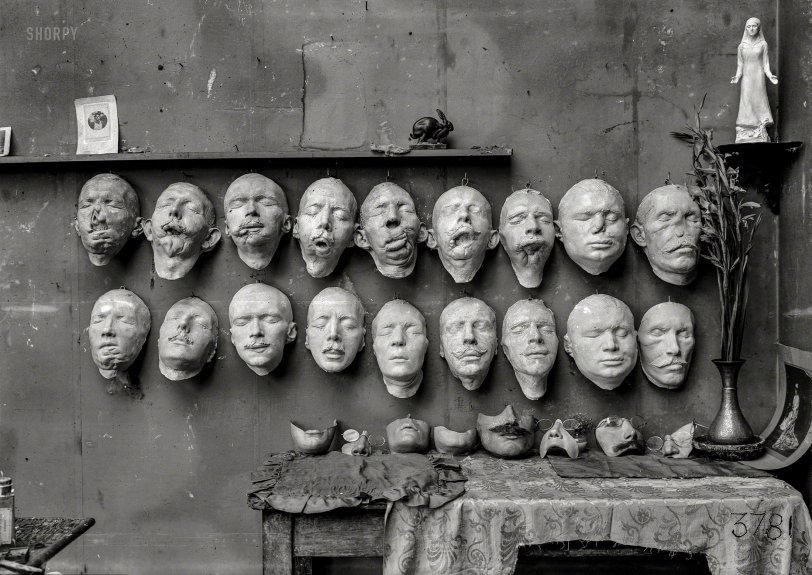


Framed or unframed, desk size to sofa size, printed by us in Arizona and Alabama since 2007. Explore now.
Shorpy is funded by you. Patreon contributors get an ad-free experience.
Learn more.

- Freeze Frame
- Texas Flyer wanted
- Just a Year Too Soon
- WWII -- Replacing men with women at the railroad crossing.
- Yes, Icing
- You kids drive me nuts!
- NOT An Easy Job
- I wonder
- Just add window boxes
- Icing Platform?
- Indiana Harbor Belt abides
- Freezing haze
- Corrections (for those who care)
- C&NW at Nelson
- Fallen Flags
- A dangerous job made worse
- Water Stop
- Passenger trains have right of way over freights?
- Coal
- Never ceases to amaze me.
- Still chuggin' (in model form)
- Great shot
- Westerly Breeze
- For the men, a trapeze
- Tickled
- Sense of loneliness ...
- 2 cents
- Charm City
- What an Outrage
- Brighton Park
Print Emporium
Masques de Guerre: 1918

August 1918. "Mutiles. Paris, France. Masks showing different stages in the work done by Mrs. Anna Coleman Ladd of the American Red Cross for soldiers whose faces have been mutilated in the war. The upper row shows casts taken from the faces as they actually are, the lower row shows the faces which Mrs. Ladd has modelled on the foundation of the life mask with the help of photographs taken before the wound was received & on the table may be seen some of the final masks made for fit over the disfigured part of the face & colored as exactly as possible like life." 5x7 glass negative by Henri A. Coles for the ANRC. View full size.
Face cases
"The first morning [at the French base hospital] an officer came in to visit a friend; his face was entirely swathed in bandages, with gaps left for his breathing and his eyes. He had been like that for two years, and looked like a leper. When he spoke he made hollow noises. His nose and lower jaw and been torn away by an exploding shell. Little by little, with infinite skill, by the grafting of bone and flesh, his face was being built up. Could any surgery be more merciful?
"In the days that followed I saw several of these masked men. The worse cases were not allowed to walk about. The ones I saw were invariably dressed with the most scrupulous care in the smartest uniforms, Sam Browns polished and buttons shining. They had hope, and took a pride in themselves – a splendid sign!
"Perhaps you ask why the face-cases should be kept in France. I was not told, but I can guess – because they dread going back to England to their girls until they've got rid of their disfigurements. So for two years through their bandages they watch the train pull out for Blighty, while the damage which was done them in the fragment of a second is repaired."
-- From "The Glory of the Trenches," by Lieutenant Coningsby Dawson, Canadian Field Artillery, 1918.
Trench warfare
Serious wounds to the head and face were not uncommon during the First World War, particularly on the Western Front where grueling trench warfare slogged on for years. Soldiers who peeked over the top of the trench were often picked off by snipers on the opposing side.
Head wounds were often fatal but facial wounds frequently resulted in terrible disfiguremrnt. In the days before plastic surgery was common, masks like these made it possible for a wounded veteran to appear in public without being stared at.
For the full story, the Smithsonian Magazine has a fascinating and detailed article on Anna Coleman and her labor of love in its archives.
























On Shorpy:
Today’s Top 5